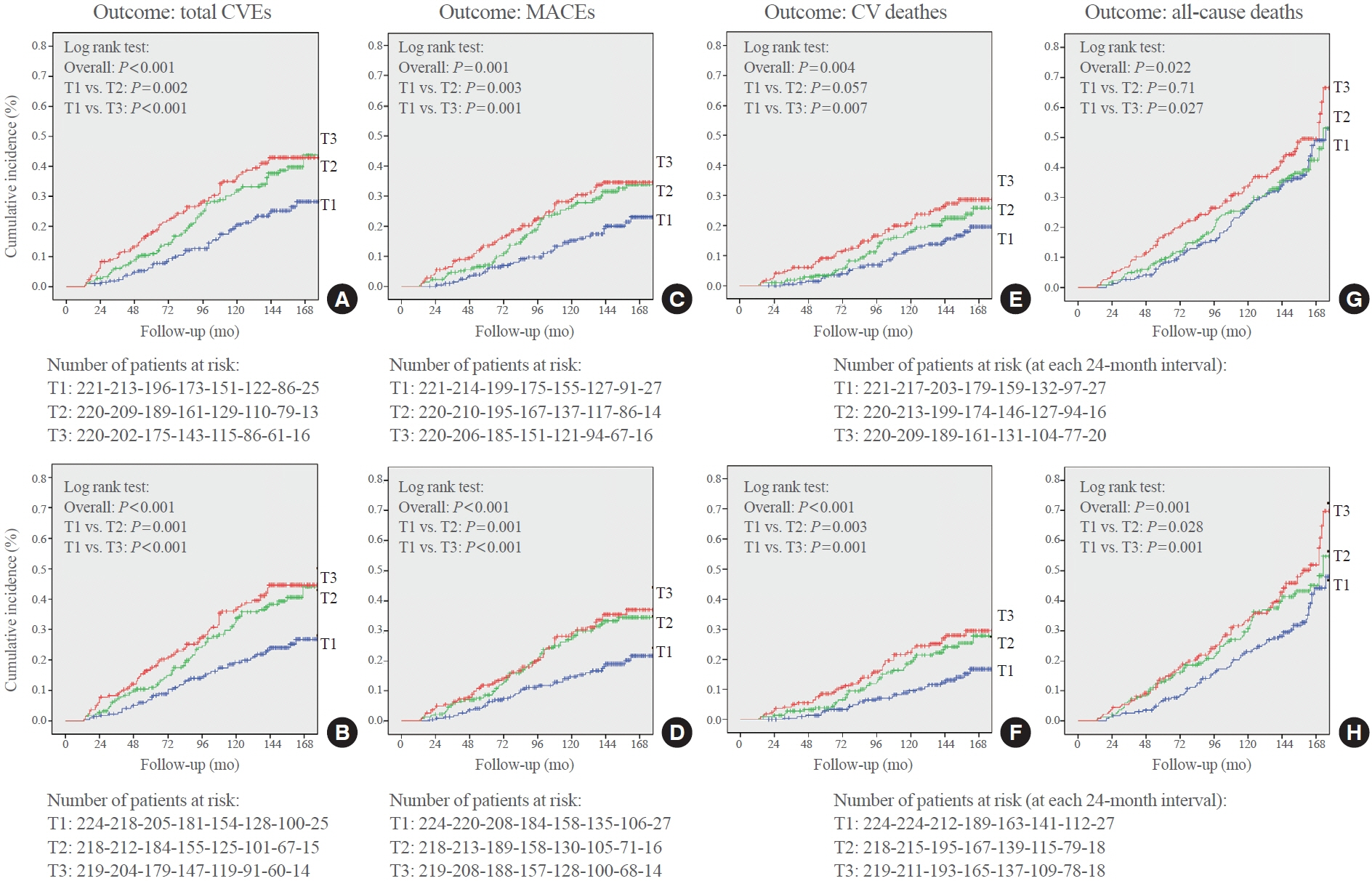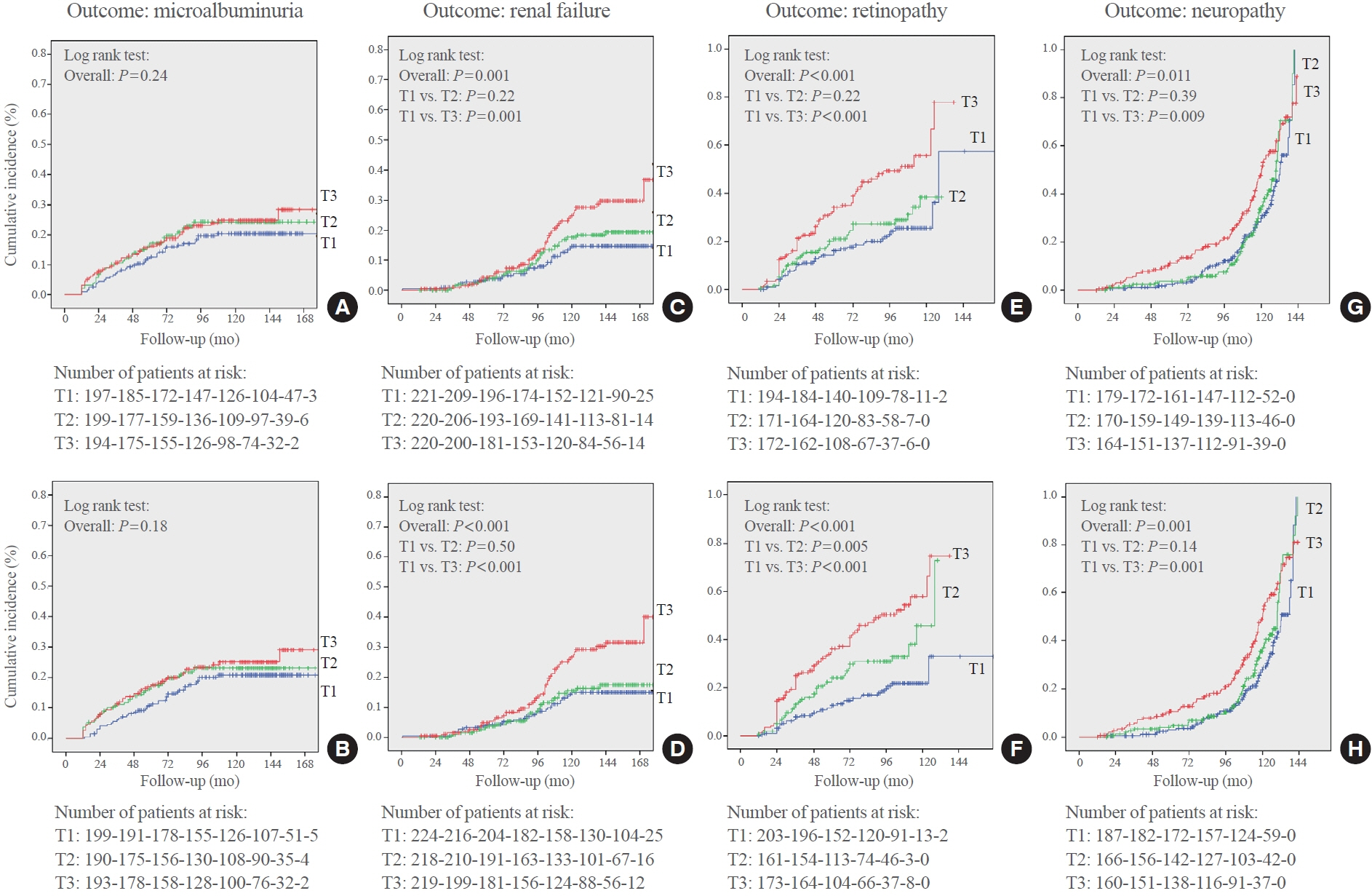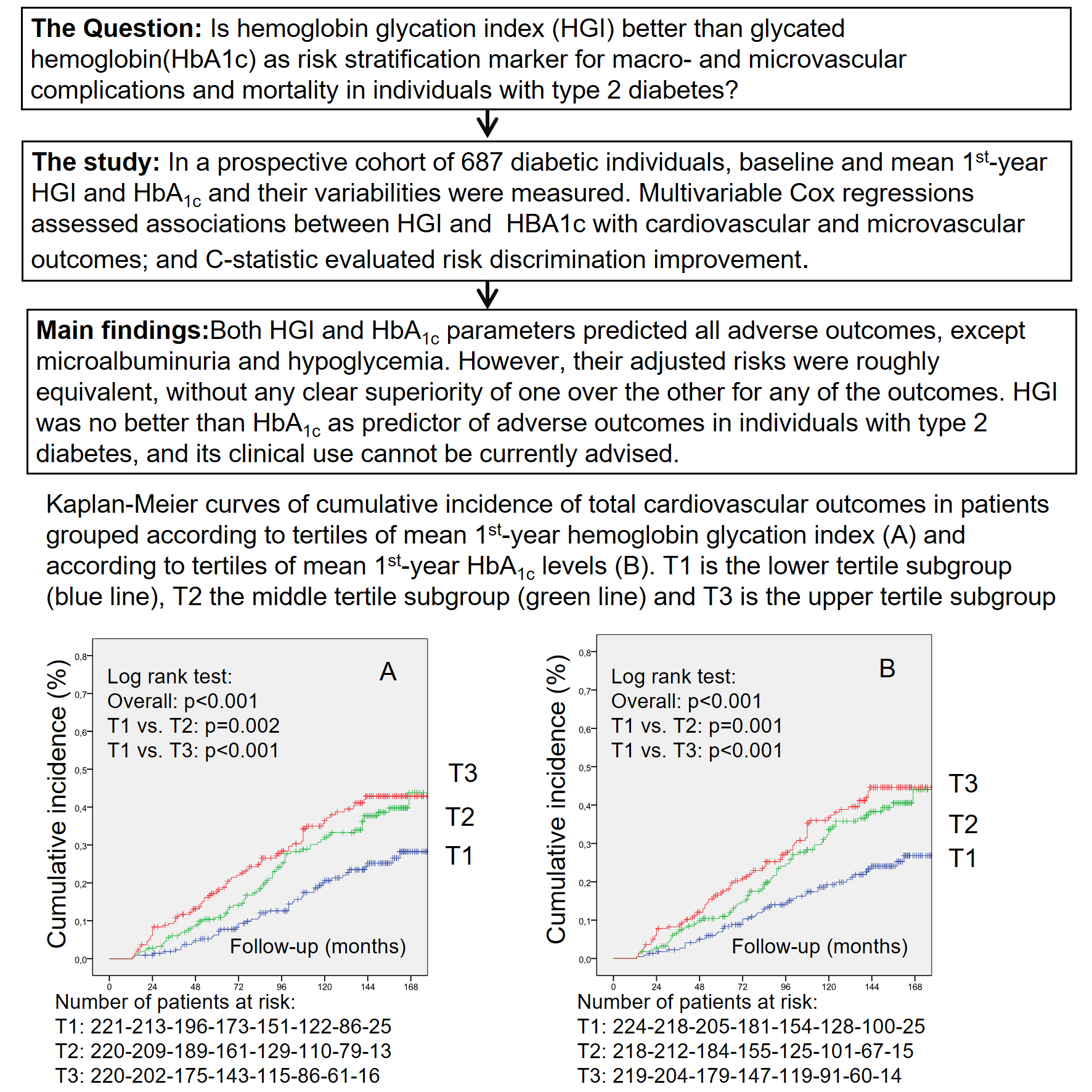Endocrinol Metab.
2024 Oct;39(5):732-747. 10.3803/EnM.2024.2001.
Importance of the Hemoglobin Glycation Index for Risk of Cardiovascular and Microvascular Complications and Mortality in Individuals with Type 2 Diabetes
- Affiliations
-
- 1Department of Internal Medicine, University Hospital Clementino Fraga Filho, School of Medicine, Federal University of Rio de Janeiro, Rio de Janeiro, Brazil
- KMID: 2560282
- DOI: http://doi.org/10.3803/EnM.2024.2001
Abstract
- Background
This study investigated the prognostic importance of the hemoglobin glycation index (HGI) for macrovascular and microvascular outcomes, mortality, and hypoglycemia occurrence in a type 2 diabetes cohort and compared it to glycated hemoglobin (HbA1c).
Methods
Baseline and mean first-year HGI and HbA1c, and the variability thereof, were assessed in 687 individuals with type 2 diabetes (median follow-up, 10.6 years). Multivariable Cox regression was conducted to evaluate the associations of HGI and HbA1c parameters with macrovascular (total and major cardiovascular events) and microvascular outcomes (microalbuminuria, advanced renal failure, retinopathy, and peripheral neuropathy), mortality (all-cause and cardiovascular), and moderate/severe hypoglycemia occurrence.
Results
During follow-up, there were 215 total cardiovascular events (176 major) and 269 all-cause deaths (131 cardiovascular). Microalbuminuria developed in 126 patients, renal failure in 104, retinopathy in 161, and neuropathy in 177. There were 90 hypoglycemia episodes. Both HGI and HbA1c predicted all adverse outcomes, except microalbuminuria and hypoglycemia. Their adjusted risks were roughly equivalent for all outcomes. For example, the adjusted hazard ratios (HRs) with 95% confidence intervals (CIs), estimated for 1 standard deviation increments, of mean first-year HGI were 1.23 (1.05 to 1.44), 1.20 (1.03 to 1.38), 1.36 (1.11 to 1.67), 1.28 (1.09 to 1.67), and 1.29 (1.09 to 1.54), respectively, for cardiovascular events, all-cause mortality, renal failure, retinopathy, and neuropathy; whereas the respective HRs (95% CIs) of mean HbA1c were 1.31 (1.12 to 1.53), 1.28 (1.11 to 1.48), 1.36 (1.11 to 1.67), 1.33 (1.14 to 1.55), and 1.29 (1.09 to 1.53).
Conclusion
HGI was no better than HbA1c as a predictor of adverse outcomes in individuals with type 2 diabetes, and its clinical use cannot be currently advised.
Keyword
Figure
Reference
-
1. Hempe JM, Gomez R, McCarter RJ Jr, Chalew SA. High and low hemoglobin glycation phenotypes in type 1 diabetes: a challenge for interpretation of glycemic control. J Diabetes Complications. 2002; 16:313–20.2. Diabetes Research in Children Network (DirecNet) Study Group, Wilson DM. Relationship of A1C to glucose concentrations in children with type 1 diabetes: assessments by high-frequency glucose determinations by sensors. Diabetes Care. 2008; 31:381–5.3. Kamps JL, Hempe JM, Chalew SA. Racial disparity in A1C independent of mean blood glucose in children with type 1 diabetes. Diabetes Care. 2010; 33:1025–7.
Article4. Wilson DM, Xing D, Cheng J, Beck RW, Hirsch I, Kollman C, et al. Persistence of individual variations in glycated hemoglobin: analysis of data from the Juvenile Diabetes Research Foundation Continuous Glucose Monitoring Randomized Trial. Diabetes Care. 2011; 34:1315–7.5. Kilpatrick ES, Rigby AS, Atkin SL. Variability in the relationship between mean plasma glucose and HbA1c: implications for the assessment of glycemic control. Clin Chem. 2007; 53:897–901.
Article6. Hempe JM, Liu S, Myers L, McCarter RJ, Buse JB, Fonseca V. The hemoglobin glycation index identifies subpopulations with harms or benefits from intensive treatment in the ACCORD trial. Diabetes Care. 2015; 38:1067–74.
Article7. Kim MK, Jeong JS, Yun JS, Kwon HS, Baek KH, Song KH, et al. Hemoglobin glycation index predicts cardiovascular disease in people with type 2 diabetes mellitus: a 10-year longitudinal cohort study. J Diabetes Complications. 2018; 32:906–10.
Article8. Kim W, Go T, Kang DR, Lee EJ, Huh JH. Hemoglobin glycation index is associated with incident chronic kidney disease in subjects with impaired glucose metabolism: a 10- year longitudinal cohort study. J Diabetes Complications. 2021; 35:107760.9. Ostergaard HB, Mandrup-Poulsen T, Berkelmans GF, van der Graaf Y, Visseren FL, Westerink J, et al. Limited benefit of haemoglobin glycation index as risk factor for cardiovascular disease in type 2 diabetes patients. Diabetes Metab. 2019; 45:254–60.
Article10. van Steen SC, Schrieks IC, Hoekstra JB, Lincoff AM, Tardif JC, Mellbin LG, et al. The haemoglobin glycation index as predictor of diabetes-related complications in the AleCardio trial. Eur J Prev Cardiol. 2017; 24:858–66.
Article11. van Steen SC, Woodward M, Chalmers J, Li Q, Marre M, Cooper ME, et al. Haemoglobin glycation index and risk for diabetes-related complications in the Action in Diabetes and Vascular Disease: Preterax and Diamicron Modified Release Controlled Evaluation (ADVANCE) trial. Diabetologia. 2018; 61:780–9.
Article12. Lachin JM, Genuth S, Nathan DM, Rutledge BN. The hemoglobin glycation index is not an independent predictor of the risk of microvascular complications in the Diabetes Control and Complications Trial. Diabetes. 2007; 56:1913–21.
Article13. Klein KR, Franek E, Marso S, Pieber TR, Pratley RE, Gowda A, et al. Hemoglobin glycation index, calculated from a single fasting glucose value, as a prediction tool for severe hypoglycemia and major adverse cardiovascular events in DEVOTE. BMJ Open Diabetes Res Care. 2021; 9:e002339.
Article14. Zhang L, Wang M, Zhang R, Zhong Y, Fan H, Wang M, et al. Hemoglobin glycation index in relationship to the risk of cardiovascular complication in patients with type 2 diabetes: a systematic review and meta-analysis. J Diabetes Complications. 2020; 34:107673.
Article15. Wu JD, Liang DL, Xie Y, Chen MY, Chen HH, Sun D, et al. Association between hemoglobin glycation index and risk of cardiovascular disease and all cause mortality in type 2 diabetic patients: a meta-analysis. Front Cardiovasc Med. 2021; 8:690689.
Article16. Lin CH, Lai YC, Chang TJ, Jiang YD, Chang YC, Chuang LM. Hemoglobin glycation index predicts renal function deterioration in patients with type 2 diabetes and a low risk of chronic kidney disease. Diabetes Res Clin Pract. 2022; 186:109834.
Article17. Cardoso CR, Leite NC, Ferreira MT, Salles GF. Prognostic importance of baseline and serial glycated hemoglobin levels in high-risk patients with type 2 diabetes: the Rio de Janeiro Type 2 Diabetes Cohort Study. Acta Diabetol. 2015; 52:21–9.
Article18. Cardoso CR, Moran CB, Marinho FS, Ferreira MT, Salles GF. Increased aortic stiffness predicts future development and progression of peripheral neuropathy in patients with type 2 diabetes: the Rio de Janeiro Type 2 Diabetes Cohort Study. Diabetologia. 2015; 58:2161–8.
Article19. Cardoso CRL, Leite NC, Dib E, Salles GF. Predictors of development and progression of retinopathy in patients with type 2 diabetes: importance of blood pressure parameters. Sci Rep. 2017; 7:4867.
Article20. Cardoso CR, Leite NC, Salles GC, Ferreira MT, Salles GF. Aortic stiffness and ambulatory blood pressure as predictors of diabetic kidney disease: a competing risks analysis from the Rio de Janeiro Type 2 Diabetes Cohort Study. Diabetologia. 2018; 61:455–65.
Article21. Cardoso CR, Salles GC, Salles GF. Prognostic importance of on-treatment clinic and ambulatory blood pressures in resistant hypertension: a cohort study. Hypertension. 2020; 75:1184–94.
Article22. DeLong ER, DeLong DM, Clarke-Pearson DL. Comparing the areas under two or more correlated receiver operating characteristic curves: a nonparametric approach. Biometrics. 1988; 44:837–45.
Article23. Rhee EJ, Cho JH, Kwon H, Park SE, Park CY, Oh KW, et al. Association between coronary artery calcification and the hemoglobin glycation index: the Kangbuk Samsung Health Study. J Clin Endocrinol Metab. 2017; 102:4634–41.
Article24. Hempe JM, Hsia DS. Variation in the hemoglobin glycation index. J Diabetes Complications. 2022; 36:108223.
Article
- Full Text Links
- Actions
-
Cited
- CITED
-
- Close
- Share
- Similar articles
-
- Importance of the Hemoglobin Glycation Index for Risk of Cardiovascular and Microvascular Complications and Mortality in Individuals with Type 2 Diabetes (Endocrinol Metab 2024;39:732-47, Claudia Regina Lopes Cardoso et al.)
- Importance of the Hemoglobin Glycation Index for Risk of Cardiovascular and Microvascular Complications and Mortality in Individuals with Type 2 Diabetes (Endocrinol Metab 2024;39:732-47, Claudia Regina Lopes Cardoso et al.)
- Frequencies and Risk Factors for Microvascular Complications in Patients with Type 1 Diabetes Mellitus
- Do Type 1 and Type 2 Diabetes Have the Same Vascular Complications?
- Association between Diabetic Polyneuropathy and Cardiovascular Complications in Type 2 Diabetic Patients




